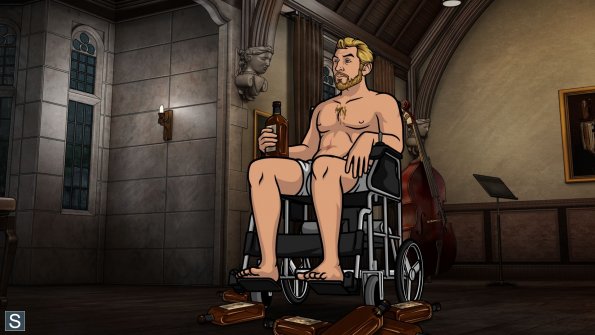
In this frame, the character of Ray Gillette, featured in the FX series, Archer, appears in a convergence of seemingly discordant images. His disheveled visage, seated in a wheelchair in an advanced state of undress, produces an absurd and disconcerting contrast when considering the formality of the baroque setting. It’s important to take in the surroundings of the character themselves – we see scattered bottles, a formal setting, and behind him, a double bass (an instrument that requires the player to stand while playing it.) Heightening this sense of dark comic absurdity are the numerous bottles which are scattered around Ray and his wheelchair. The frame implicitly connects Ray’s use of a wheelchair with his excess drinking by their inclusion and proximity to himself. Furthermore, it seems to suggest a tacit connection between his disability and his drinking to excess – something which is often associated with “weak” or immoral behavior. It’s unclear as to whether the marks on his chest are hair or spilled alcohol from one of the bottles – again, the image ties alcoholism to disability in a very stark contrasting way. It’s important to point this out because it reaffirms the notion that disability will lead to other problems in life, and those problems may be other disabilities, such as dependence and substance abuse. Such assumptions surrounding disability are common and damaging. However, the tone of Archer is often irreverent to the extreme, and its disregard is so exaggerated that the humorous inflection of the show begins to destabilize many cultural notions that are often taken for granted. The viewer looks up at Ray from a vantage that places him in a way that appears to be reverence, but, because of his countenance, threatens to collapse into a mockery. He’s physically very fit as if he needs to be fit and drink alcohol in order to counteract the weakness of being in a wheelchair. This “weakness” is perceived as a threat to his masculinity. The wheelchair itself also seems rather useless – the wheels are incredibly small. It seems as if the wheelchair is just an accessory and not an actual part of his character. It’s used for comedic effect. Again, heightening this potential sense of mockery is the background in which Ray is set. The busts on the wall, the classical instruments, and the ornate décor – all of which are class signifiers – contrast against Ray’s figure, further emphasizing the ways in which Ray appears absurdly out of place in the scene. These all combine in ways which suggest a clash between disability and social status or power.
